Chapter 10:
Extracts From C. E. W. Bean
24th and 56th Battalions
EDITED EXTRACTS FROM C.E.W. BEAN'S HISTORY OF W.W.I.
Below are excerpts listed from Bean's History of the First World War, as extracted by my cousin Clyde Smythe and myself. I have used capital letters for the name of the family member. The bracketed numbers refer to footnotes about the SMYTHE brothers. I have omitted the others.
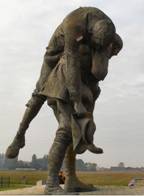 Cobbers Memorial at
Cobbers Memorial at
Fromelles (Side View)
October 2007Volume 3, Ch. 13, Page 433 (Battle of Fromelles) 20 July 1916 - "For some reason the order for withdrawal seems not to have been received by the 14th Brigade report-centre until 7.3, or by Cass until 7.50. The Barrage around his position had been ordered long before, and began to fall at 5.40; and to the long delay which followed must be attributed to the loss of a great part of Cass's right flank. On receipt of the final order he at once passed word for his men to move to the rear through the well-traversed trench across No-Man's Land, which, with the help of CAPTAIN SMYTHE'S (207) company of the 56th and Captain Scott's of the 5th Pioneers, had now been dug from four to six feet deep and duckboarded through to the old German front. At the first command to withdraw there was some disorganisation, part of the men around Cass's headquarters attempting to run across the open to their old trenches. The enemy turned upon them with machine-guns and they lost heavily.
(This officer was Captain Vern Smythe and he was later awarded a Military Cross)

The 1st Division Memorial on
'K' Trench at PozieresVolume 3, Ch. 18, Page 618 (Pozieres Heights) - 27 July 1916 - "Some tried to occupy their minds by playing cards (82). The company of the 22nd in this trench lost all its officers and a great part of its men through this bombardment; and so great was the carnage in the 24th that for months afterwards, even when "K" Sap had almost been obliterated, its course could easily be traced by the half-buried bodies with the red and white colours of the battalion still showing on their arms. At the eastern end of the village the 19th Battalion had been heavily bombarded; and the old semicircular trench of the 11th and 12th Battalions behind the northern edge of the village etc." (82) - "It is related in the history of the 24th Battalion (The Red and White Diamond - Page 95), that an officer passing along "K" trench saw four men playing cards. On the parapet above them was the body of their sergeant who had been playing cards with them, his hand, being taken by a mate. When the officer passed that way again, those four men were dead."
(This officer was Lieutenant (later Captain) Viv Smythe)
Volume 3, Ch. 23, Page 818 (Last Attack on Mouquet Farm) - 26 August 1916
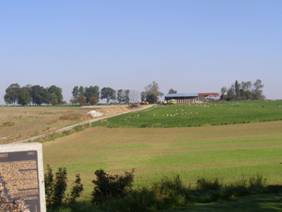 Mouquet Farm October 2007 - the old farm was
Mouquet Farm October 2007 - the old farm was
on the left side of the road."The isolated Victorians being evidently in a desperate situation, the artillery barrage was called down north of the farm at 10.20 a.m. Gellibrand ordered the 24th to suppress the enemy in the farm by two bombing attacks from the south and south-east. This perilous duty was accepted by LIEUTENANT SMYTHE, (36) and the parties were organised: but, as the artillery could not be employed for fear of hitting the isolated troops, and the available trench-mortars were in positions from which the objective could not be hit, the order was at the last moment cancelled. A renewal of the attack on Point 54, ordered for noon after renewed bombardment by heavy artillery, also remained unattempted, apparently because the artillery had overshot their target. The abandonment of these projects was fortunate: it is unbelievable that such efforts made in broad daylight against an alert enemy strongly occupying positions of great strength had any chance of success."
(This officer was Lieutenant Viv Smythe - after that Viv was called Mouquet Bill)
Volume 4, Ch. 10, Page 361 (Lagnicourt) - 13-14 April 1917 - "Above the canal south-east of Hermes, a party of the 3rd Battalion was fired on by the Germans in a square copse which it had been ordered to occupy. (This was mentioned in Bert's diary dated 13th) There are quite a few mentions of actions by the 3rd Battalion (Bert's) on Pages 361, 363, 364 and 367. On Page 364, there is a notation at the bottom of the page which reads "It caught the 3rd Battalion's Brass Band, whose members had for the first time been ordered forward to carry rations to the front. The battalion is said to have gone without breakfast."
Volume 4, Ch. 12, Page 436 (Second Battle of Bullecourt) - 3 May 1917. (This was the day that Bert and his second cousin Julius CLARKE were killed and Julius' brother Hercules was injured and died the following day.) "The 24th Battalion which, with the 23rd behind it, advancing along the depression, next to the road, reached the wire with little loss. A German machine-gun which fired at them through the barrage was silenced by Lewis gunners shooting from the hip as they advanced. At the wire the rear waves came up too close, and in the craterfield there the order of the battalion was broken, and (Cont'd Page 437)
Volume 4, Ch. 12, Page 437 (Second Battle of Bullecourt) - still dated 3 May 1917 - the troops pressed forward dangerously close to the barrage; but when it lifted they were in the German trench with the last shell, and the enemy garrison, having no time to leave its dugouts was easily suppressed. Looking over their shoulders as they entered the trench, the Victorians on the right saw the failure of the 5th Brigade.
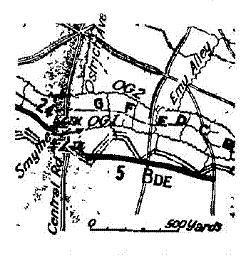 See Smythe name on the far left of map
See Smythe name on the far left of mapEveryone knew the plans and objectives, and so, as a matter of course, LIEUTENANT SMYTHE of the leading company of the 24th, after capturing O.G.1. in his sector, led a party into that trench on the 5th Brigade's side of the road, bombing the dugouts as he went. He met no opposition until, when 200 yards along the trench, he came close upon some German machine-gunners who were busily firing towards the Australian lines. As SMYTHE had insufficient force for attacking them, he had to be content with exchanging a few bombs and revolver shots, and then stationed a post two bays further back to block the trench and safeguard the flank.
(Continuing further down the page)
The three following waves of the 24th and those of the 23rd had meanwhile passed over O.G.1. to the left of the road, and had then lain close to the barrage as it fell on O.G.2. At 4.16, the moment it lifted, these troops too were into the trench before the Germans were ready to meet them. Here the 24th captured a machine-gun, two light trench mortars, an automatic rifle and a Lewis Gun."
Volume 4, Ch. 12, Page 448 (Second Battle of Bullecourt) - still dated 3 May 1917 - "It was only a few minutes earlier that LIEUTENANT SMYTHE of the 24th had placed his flank-guard 200 yards along this trench. He was returning down it to his proper sector when he saw the last of Gilchrist's attack, and immediately afterwards came upon that very keen officer hurrying eastward, quite alone, along O.G.1. "These men are all right. All they want is a leader!" said Gilchrist. When SMYTHE began to explain the position to him, "All they need is a leader," Gilchrist repeated, and pushed past him down the trench.
(This officer was Lieutenant (later Captain) Viv Smythe)
Volume 4, Ch. 12, Page 456 (Second Battle of Bullecourt) - still dated 3 May 1917 - a note at the bottom of the page states) - "LIEUTENANT SMYTHE of the 24th most gallantly devoted part of his own small bomb store (for use by Captain Gilchrist of the 18th Battalion) and charged one of his NCO's to keep up the supply."
(This officer was Lieutenant (later Captain) Viv Smythe)
Volume 4, Ch.12. Page 488 (Second Battle of Bullecourt) - 3rd-4th May 1917 - "Then tired, unkempt, reduced in numbers but bursting with pride the 6th Brigade came out. (After their part in the battle). This was early 4 May and they had to fight off a German counter attack that was beaten off. Its men looked for no recognition of their victory and none awaited them. No special congratulations awaited them, no high commander picked them out for special approbation. Indeed the higher command knew little of what the Brigade had done. It's four Battalions came back into close reserve from which they organised as four companies of a single Battalion that daily helped others to secure the foothold they had seized. But their achievement won them a tribute which they would have prized beyond all others.
An officer of the 2nd Battalion records that his incoming troops, forced to trample on the dead crowded in the narrow trenches, were at great pains during that day to avoid stepping on any whose sleeve carried the red and white patch of the 24th Battalion. "We understood that it was they who took this position," he says simply. In the whole battle from Vimy to Queant, theirs had been almost the only success." (On a note at the bottom of the page was written) "Also a British airman flying very low over the headquarters of the brigade on the afternoon of the 3rd dropped a message - "Well done Australia!"
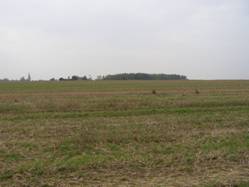 Across the Fields at Bullecourt looking
Across the Fields at Bullecourt looking
towards the Memorial, Oct 2007
(Note: I think these two tributes were a wonderful way to pay respect to the men who lost their lives and those who fought so well in this battle.
The 3rd May was the day that Bert was killed when the 3rd battalion relieved Viv's 24th)
Volume 4, Ch. 19, Pages 826-827 (Polygon Wood) - 26 September 1917 - "The 14th Brigade's second objective included 1,000 yards of the Flandern 1 Line, and a number of pillboxes. Then the 56th and the 55th launched this final stage of the advance at 7.30, they found the Flandern Line recognisable only by the shreds of the entanglement, and the pillboxes were easily taken, but sharp fire came from the right. The source of this was the German Headquarters at Polygonebeek, which at the moment lay short of the barrage and unattacked by the 29th, which was not yet up. Company Sergeant-Major Brewer and Loney were killed trying to remedy this. Captain Plomley (56th) sent Lieutenant Scott to secure the flank, but the place was soon afterwards taken by the 29th. The 56th and 55th passed the Flandern Line and were fired on by machine-guns from two pillboxes beyond. CAPTAIN SMYTHE (56th) with some of his men captured one of these together with 15 Germans and Lieutenant Slater with three of the 55th took another and 30 prisoners. This for the time ended serious resistance, and the Australian infantry with characteristic nonchalance, roamed over the plateau."
(This officer was Captain Vern Smythe and the action for which he was awarded a Bar to his Military Cross)
 Note Smythe name in the middle with arrow pointing to pillbox
Note Smythe name in the middle with arrow pointing to pillbox Volume 4, Ch. 21, Page 896 (Passchendaele 1) - 9 October 1917 -
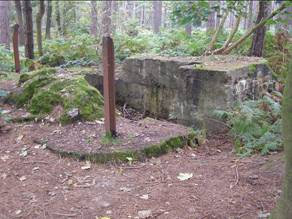 A pillbox in Polygon Wood
A pillbox in Polygon Wood"Meanwhile the enemy had just reached the wood when suddenly a machine-gun was suddenly switched on it from near Dairy Wood, 150 yards farther north. This almost wiped out the left. Under CAPTAIN SMYTHE the centre had pushed on into the copse, a thin stubble resembling Polygon Wood, and now swung round facing this gun. It was most difficult to detect, but Lieutenant Scales and Sergeant Radley eventually caught sight of it in a heap of bricks between Daisy and Dairy Woods. They sniped several of the Germans, who thenceforward could only make hurried shots.
(This officer was Captain Viv Smythe - was awarded a bar to his Military Cross)
Volume 4. Ch. 21, Page 899 (Passchendaele 1 - Daisy Wood) 9 October 1917 - "CAPTAIN SMYTHE (24th) with Lieutenant and Sergeant O'Hara (19th) and Lieutenant Gow (24th), enclosed the wood in a line of posts. Before dark, through the persistency of Taylor and SMYTHE, the essential parts of the 6th Brigade's objective had been secured."
(He was promoted to temporary Major after the war and was in charge of the demobolisation of the unit in the field and conducting courts martial)
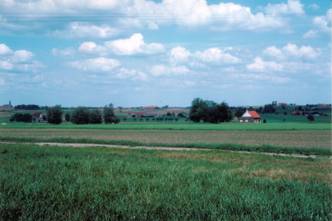
This photograph was taken (1976 by cousin Clyde) in the vicinity of Daisy Wood (and Dairy Wood) where Viv's brother Vern was fighting. Broodseinde Ridge extends for quite a distance and it was hard to locate areas to take a good photograph in 2007.
NEXT >>














